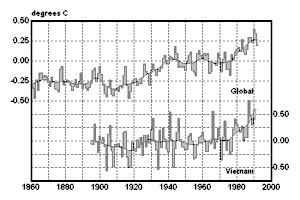 Impact on Vietnam
Impact on Vietnam Impact on Vietnam
Impact on VietnamPast variations in the climate of Vietnam provide an important context for the future changes that may accompany global warming. They can be used to assess the significance of future trends. Their consequences for human welfare indicate the nature and scale of the potential impact of global warming.
The climate record for much of the region begins in the late 19th century. The annual temperature record shows that temperatures remained relatively constant over much of the period 1895-1980. Abrupt warming has occurred since the 1970s.
The net warming over the period of record amounts to 0.27 deg. C. Over the region as a whole, the warming has been greatest in the spring months.
 Annual surface air temperature for the globe (upper time series) and for the region
of Vietnam (lower time series).
Annual surface air temperature for the globe (upper time series) and for the region
of Vietnam (lower time series).
More detailed analysis of observations for the past 30 years indicates that temperatures have tended to be higher in the south in recent years, with the trend being most noticeable in the summer months.
Variations in rainfall amount have also been observed in recent decades. Since the 1960s, there has been an increase in annual rainfall in the north of Vietnam and a decrease in the south.
The Hydrometeorological Service has studied longer-term variations in water availability. This research has shown that a marked decrease in run-off affected both the Red River and the Mekong River during the 1940s and 1950s.
From the late 1960s to the present, the run-off of the Lo River has been increasing. Measurements taken on the Mekong River at Vientiane also indicate an increase in run-off during the 1960s.
These trends in run-off are due to a combination of human influence and fluctuations in rainfall over the catchment areas of the rivers. Analysis of relevant rainfall data indicates a variable pattern of trends in time and space over recent decades, although the main features of the trends agree with the assessment of run-off variations.
The risk of extreme weather events has also varied over the years. According to data collected by the Hydrometeorological Service, there has been an increase in the number of tropical cyclones affecting Vietnam since the 1950s.
Long data series for the chief stations in the low-lying plains in the north and south of Vietnam have been examined for evidence of sea level rise.
The longest and most reliable record is for Hondau in North Vietnam. A sea level rise of 0.19 cm a year has been observed at this station over the period 1955-1990. This is in broad agreement with the observed rise in global-mean sea level.
The station at Vungtau in South Vietnam shows a different trend. This may be an unreliable result as the siting of this station has changed, although stations in Central Vietnam also show a different trend from Hondau.
It is impossible at this time to determine whether these past trends in climate and sea level are the result of global warming or natural climate variability, or to a combination of these factors.
Whatever the cause, it is clear that the climate of Vietnam is already undergoing considerable change which should be taken into account when formulating development plans.
Based on material provided by
Dr Nguyen Huu Ninh, Director, Center for Environment Research Education and Development
Dr Hoang Minh Hien, Hydrometeorological Service
Professor Nguyen Ngoc Thuy, Director, Marine Hydrometeorological Centre
Dr Tranh Thanh Xuan, Hydrometeorological Service
 "Impact on Vietnam: Future changes in climate and sea level"
"Impact on Vietnam: Future changes in climate and sea level" Index
Index